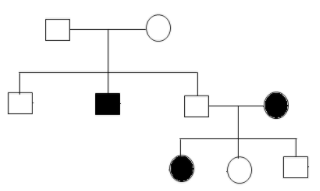
From the following pedigree chart of a family, one can make an analysis that,

A. It is an autosomal dominant trait
B. It is an autosomal recessive trait
C. It is an autosomal dominant trait
D. It is an autosomal recessive trait

Answer
484.2k+ views
Hint:The parents of a person with an autosomal recessive condition often have a copy of the mutant gene, but normally do not exhibit symptoms and signs of the disorder.
Complete Answer:
The theory that diseases are hereditary was based on the heritability of such traits of communities. After the rediscovery of Mendel's study, the tradition of analyzing the cycle of inheritance of human characteristics started. As it is apparent that control crosses that can be done in pea plants or in certain other species are not possible in the case of human beings, the study of the family history of the inheritance of a specific trait offers an alternative. Such a study of the characteristics in a few generations of the family is termed a pedigree analysis.
A variety of human diseases have been found to be associated with the inheritance of modified or changed genes or chromosomes. By pedigree analysis, it is easy to grasp whether the phenotype in question is recessive or dominant. Similarly, the feature can also be linked to the sex chromosome. It is clear that this X-linked recessive phenotype indicates the transmission from the female carrier to the male parent.
When no parents are affected but develop affected children, they would be heterozygous and thus this condition would be autosomal recessive. Such a condition is more prevalent among the children of marriage with closely related people.
Thus, the correct answer is option B. i.e., It is an autosomal recessive trait.
Note:The inheritance of a single characteristic is reflected in the pedigree analysis over generations of the family tree. In human genetics, the pedigree analysis offers an important instrument that is used to track the descent of a particular trait, abnormality or disorder.
Complete Answer:
The theory that diseases are hereditary was based on the heritability of such traits of communities. After the rediscovery of Mendel's study, the tradition of analyzing the cycle of inheritance of human characteristics started. As it is apparent that control crosses that can be done in pea plants or in certain other species are not possible in the case of human beings, the study of the family history of the inheritance of a specific trait offers an alternative. Such a study of the characteristics in a few generations of the family is termed a pedigree analysis.
A variety of human diseases have been found to be associated with the inheritance of modified or changed genes or chromosomes. By pedigree analysis, it is easy to grasp whether the phenotype in question is recessive or dominant. Similarly, the feature can also be linked to the sex chromosome. It is clear that this X-linked recessive phenotype indicates the transmission from the female carrier to the male parent.
When no parents are affected but develop affected children, they would be heterozygous and thus this condition would be autosomal recessive. Such a condition is more prevalent among the children of marriage with closely related people.
Thus, the correct answer is option B. i.e., It is an autosomal recessive trait.
Note:The inheritance of a single characteristic is reflected in the pedigree analysis over generations of the family tree. In human genetics, the pedigree analysis offers an important instrument that is used to track the descent of a particular trait, abnormality or disorder.
Recently Updated Pages
The correct geometry and hybridization for XeF4 are class 11 chemistry CBSE

Water softening by Clarks process uses ACalcium bicarbonate class 11 chemistry CBSE

With reference to graphite and diamond which of the class 11 chemistry CBSE

A certain household has consumed 250 units of energy class 11 physics CBSE

The lightest metal known is A beryllium B lithium C class 11 chemistry CBSE

What is the formula mass of the iodine molecule class 11 chemistry CBSE

Trending doubts
What is the modal class for the following table given class 11 maths CBSE

Give an example of a solid solution in which the solute class 11 chemistry CBSE

Describe the effects of the Second World War class 11 social science CBSE

Which of the following methods is suitable for preventing class 11 chemistry CBSE

Number of oneone functions from A to B where nA 4 and class 11 maths CBSE

What organs are located on the left side of your body class 11 biology CBSE




